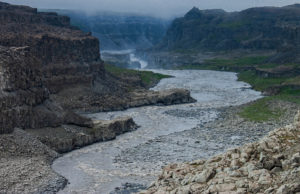This resource is a basic introduction to looking at rocks in thin section. The resource includes a section outlining the parts of a polarising light microscope. There is a section showing how this microscope can be used to study the optical properties of minerals in rock thin section. There are video clips showing the optical properties of minerals in a number of rock thin sections. The thin sections, covering a range of igneous, metamorphic and sedimentary rocks, were chosen to show the diagnostic properties of 10 of the main rock-forming minerals as seen under a polarising light microscope.

Polarising light microscope (2.38 MB)
This PowerPoint shows the main parts of the type of microscope used to study minerals in rock thin sections.

Minerals in thin section (8.84 MB)
This outlines the optical properties of minerals observed using a polarising light microscope.

Thin section 1
This video shows a thin section of a rock made of quartz, feldspar and lithic grains. The properties of the main rock-forming minerals as seen under a polarising light microscope are described. Images in this resource could be used to practise microscope drawing skills.

Thin section 2
This video shows a thin section of a rock made of quartz, feldspar biotite mica and muscovite mica. The properties of the main rock-forming minerals as seen under a polarising light microscope are described. Images in this resource could be used to practise microscope drawing skills.

Thin section 3
This video shows a thin section of a rock made of feldspar, olivine and pyroxene. The properties of the main rock-forming minerals as seen under a polarising light microscope are described. Images in this resource could be used to practise microscope drawing skills.

Thin section 4
This video shows a thin section of a rock made of quartz, muscovite mica, biotite mica and garnet. The properties of the main rock-forming minerals as seen under a polarising light microscope are described. Images in this resource could be used to practise microscope drawing skills.

Thin section 5
This video shows a thin section of a rock made of calcite and which is largely composed of skeletal grains (bioclasts). The properties of the main rock-forming minerals as seen under a polarising light microscope are described. Images in this resource could be used to practise microscope drawing skills.

Thin section 6
This video shows a thin section of a rock made of calcite and which is largely composed of non-skeletal grains. The properties of the main rock-forming minerals as seen under a polarising light microscope are described. Images in this resource could be used to practise microscope drawing skills.

Thin section 7
This is a thin section of a rock largely made of quartz grains. Images in this resource could be used to practise microscope drawing skills. Try comparing this thin section with the thin sections shown in ‘Microscopy: sedimentary rocks’ in the resources section of GeoHubLiverpool.

Thin section 8
This is a thin section of a rock made of crystals of, plagioclase feldspar, K-feldspar or orthoclase feldspar and quartz. Small amounts of biotite mica also occur. Images in this resource could be used to practise microscope drawing skills. Try comparing this thin section with the thin sections shown in ‘Microscopy: igneous rocks’ in the resources section of GeoHubLiverpool

Thin section 9
This is a thin section of a rock made of quartz, plagioclase feldspar, K-feldspar, biotite mica and muscovite mica grains. Images in this resource could be used to practise microscope drawing skills. Try comparing this thin section with the thin sections shown in ‘Microscopy: sedimentary rocks’ in the resources section of GeoHubLiverpool

Thin section 10
This is a thin section of a rock largely made of crystals of plagioclase feldspar and pyroxene. Small amounts of amphibole and opaque iron oxides also occur. It shows a porphyritic texture. Images in this resource could be used to practise microscope drawing skills. Try comparing this thin section with the thin sections shown in ‘Microscopy: igneous rocks’ in the resources section of GeoHubLiverpool

Thin section 11
This is a thin section of a rock made of crystals of hornblende, plagioclase feldspar, quartz, and garnet. Sphene occurs as an accessory mineral. Images in this resource could be used to practise microscope drawing skills. Try comparing this thin section with the thin sections shown in ‘Microscopy: metamorphic rocks’ in the resources section of GeoHubLiverpool

Thin section 12
This is a thin section of a rock largely made up of calcite grains. Images in this resource could be used to practise microscope drawing skills. Try comparing this thin section with the other thin sections shown in ‘Microscopy: metamorphic rocks’ in the resource section of GeoHubLiverpool.

Thin section 13
This is a thin section of a rock largely made up of quartz grains. Images in this resource could be used to practise microscope drawing skills. Try comparing this thin section with the other thin sections shown in ‘Microscopy: metamorphic rocks’ in the resource section of GeoHubLiverpool.


